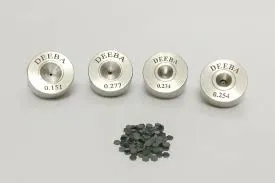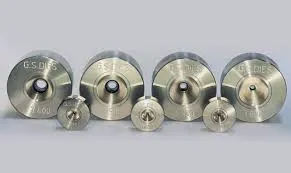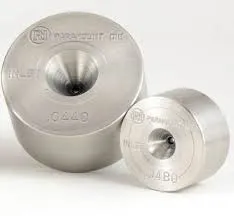PCD dies are also known as Polycrystalline Diamond dies, and they are crucial elements in the wire drawing industry. These diamond-plated tools are responsible for giving different wires such as copper, aluminum, tungsten, or special alloys the desired shapes and fine finish.
The purpose of this article is to discuss PCD dies, including their definition, how they work, their advantages, and why they are very important in the process of wire drawing.
What Are PCD Dies?
Basically, PCD dies refer to polycrystalline diamond, which is a synthetic material designed with hardness and durability advantages. Polycrystalline diamond is formed through sintering diamond particles under high pressure and temperature, making it harder than natural diamonds.
They are made into various shapes such as cylinders or cones, or anything else required for shaping the final product. The wire is pulled through a die opening using polycrystalline diamond dies to reduce its diameter during the wire drawing process. Using a metal wire for drawing purposes makes it durable enough to withstand the tear and wear metals can cause on it, but still minimize its cross-sectional area from reducing in size. The usefulness of the materials whose sharpness doesn’t decay in the production of quality wires underscores why these PCDs stand out.
Types of Polycrystalline Diamond Dies
There are numerous kinds of polycrystalline diamond dies, and each type meets certain requirements in wire drawing. A few of them include:
Self-Supported polycrystalline diamond dies: These dies have no backing material, meaning they are self-supported. They are usually used for low to medium drawing speeds.
Supported by a Backing Material polycrystalline diamond dies: In this type of die, the diamond is supported by tungsten carbide or other materials. This kind suits high-speed drawing applications quite well.
Thermally Stable polycrystalline diamond dies: They are created to endure high temperatures and can be used in places where heat is an issue.
The advantages that come with each of these depend on the purpose as well as the type of wire being drawn.

The Advantages of Polycrystalline Diamond Dies
Why should you consider using polycrystalline diamond dies? The advantages are clear:
Extreme Durability: polycrystalline diamond dies are highly durable because polycrystalline diamond is very hard, enabling it to withstand intense friction caused during wire drawing. Consequently, other types of dies wear out more quickly than PCD, thus reducing their replacement rates.
Precision: For instance, the polycrystalline diamond die is highly precise because it assures that the wire drawn will conform to specific requirements. This is especially significant in industries where cables are subject to strict size and quality control.
Superior Surface Finish: The use of polycrystalline diamond dies helps to produce uniform surface finishes on wires. In cases like when manufacturing electrical or high-performing wires where nail heads may come in contact with surfaces constantly, surface quality matters a lot.
Cost-Effectiveness: While PCD dies can be more expensive at first than other types of dies, they are cost-effective in the long run due to their durability and precision. Over time, less die replacement and fewer production disruptions help save money for companies.
Versatility: PCD dies can be used for drawing different wire types made from ferrous and nonferrous metals. They work well with copper, aluminum, tungsten, stainless steel as well as special alloys being used today. This is why they have become popular in various industries.
The PCD Dies Used in Wire Drawing
The main use of polycrystalline diamond dies is in wire drawing, which is a process that involves the pulling of a wire through a die to reduce its diameter. The following describes how the process works:
Wire Preparation: This first stage involves the preparation and cleaning of the wire to remove any impurities that might interfere with its drawing.
Die Insertion: After that, the wire is pulled through a die made from polycrystalline diamond (PCD), which causes it to shrink and narrow down.
Drawing Speed: Then, at high speed, the wire is dragged via the die. The hardness of polycrystalline diamond die ensures that this mold will remain intact among other things, as it should not wear out fast.
Wire Output: After drawing, it becomes critically important to measure the cable precisely so that it adheres to desired specifications.
Through every step, including minimal defects and constant quality drawdowns, polycrystalline diamond die makes sure you get perfect wires drawn throughout. For the purpose of creating high-quality wires where precision is important, this material’s hardness also makes it ideal for use.
Some Common Applications of PCD Dies
Different industries utilize polycrystalline diamond dies in a lot of ways. Listed below are some of the areas where they are used most frequently:
Electrical Wire Manufacturing: With the need to uphold their originality and transmit electricity effectively, this product is suitable for electrical wire drawing. The surface finish obtained via using PCD dies lowers resistance and enhances conductivity.
Automotive Industry: Wires used in manufacturing automotive parts must be strong but also flexible, hence the application of PCD dies.
Aerospace: Wire for aerospace applications must be very strong and precise. These high-quality wires produced by polycrystalline diamond dies can handle extreme conditions.
Precious Metal Wire: PCD dies are also used in precious metal wire drawing, such as for gold or silver. When working with such valuable materials, accuracy and surface finish cannot be compromised.

How Do PCD Dies Compare to Other Types of Dies?
However, it will be good to put them side by side with other types of dies to know when they can be preferred over others:
Tungsten Carbide Dies: Tungsten carbide is also a popular material for wire drawing dies. Yet, tungsten carbide isn’t as wear-resistant and precise in service as polycrystalline diamond dies, although it is strong and hard. Moreover, the process of drawing harder metals may cause damage to tungsten carbide dies.
Steel Dies: Steel dies are the most basic type of dies used in wire drawing. They cost less than PCD and tungsten carbide dies but lose shape faster than PCD dies do.
When it comes to high-performance wire drawing, polycrystalline diamond dies are often the superior choice due to their hardness, durability, and precision.
Challenges of Using Polycrystalline Diamond Dies
Though polycrystalline diamond dies offer many advantages, there are certain challenges that manufacturers must know:
Cost: Some companies may be deterred by how expensive polycrystalline diamond dies are compared with other kinds of dies for lower-volume production, especially.
Brittleness: Despite being very hard, polycrystalline diamond (PCD) can be brittle. For instance, if one drops or handles a die wrongly, it can crack or break.
Machining Complexity: There is complexity in manufacturing and machining PCD dies, which needs specialized equipment. This increases the cost as well as the time spent in producing these types of tools.
Nonetheless, the benefits of polycrystalline diamond dies usually outweigh any disadvantages they may possess, especially if high-quality wire is required.

Conclusion
In drawing wire, PCD dies are essential because they offer the highest durability, precision, and flexibility. Whether you are using non-ferrous or ferrous metals, these polycrystalline diamond dies guarantee that the wire will be finished better, and production will be maintained. Although their initial cost is a bit higher, their long lifespan and ability to enhance product quality make them a smart investment for many industries.
Therefore, do you want to invest in PCD dies that will push your wire drawing process forward?
FAQs
Are PCD dies better than tungsten carbide dies?
Yes, generally, PCD dies are more preferable than tungsten carbide dies due to their wear resistance rate, accuracy, and longevity.
What metals can be drawn using PCD dies?
PCD dies are versatile enough for use with various metals including copper, aluminum, tungsten, stainless steel, and special alloys.
How long do PCD dies last?
PCD dies are highly durable; hence, they outlast other types of molds that require constant replacement.
Is PCD suitable for fast drawing?
Yes, supported PCD dies are intended to effectively handle fast drawing applications.
Are PCD dies applicable for any wire kinds?
The application of the PCD die extends to many wire types such as electrical, automotive, aerospace, and precious metal wires.










